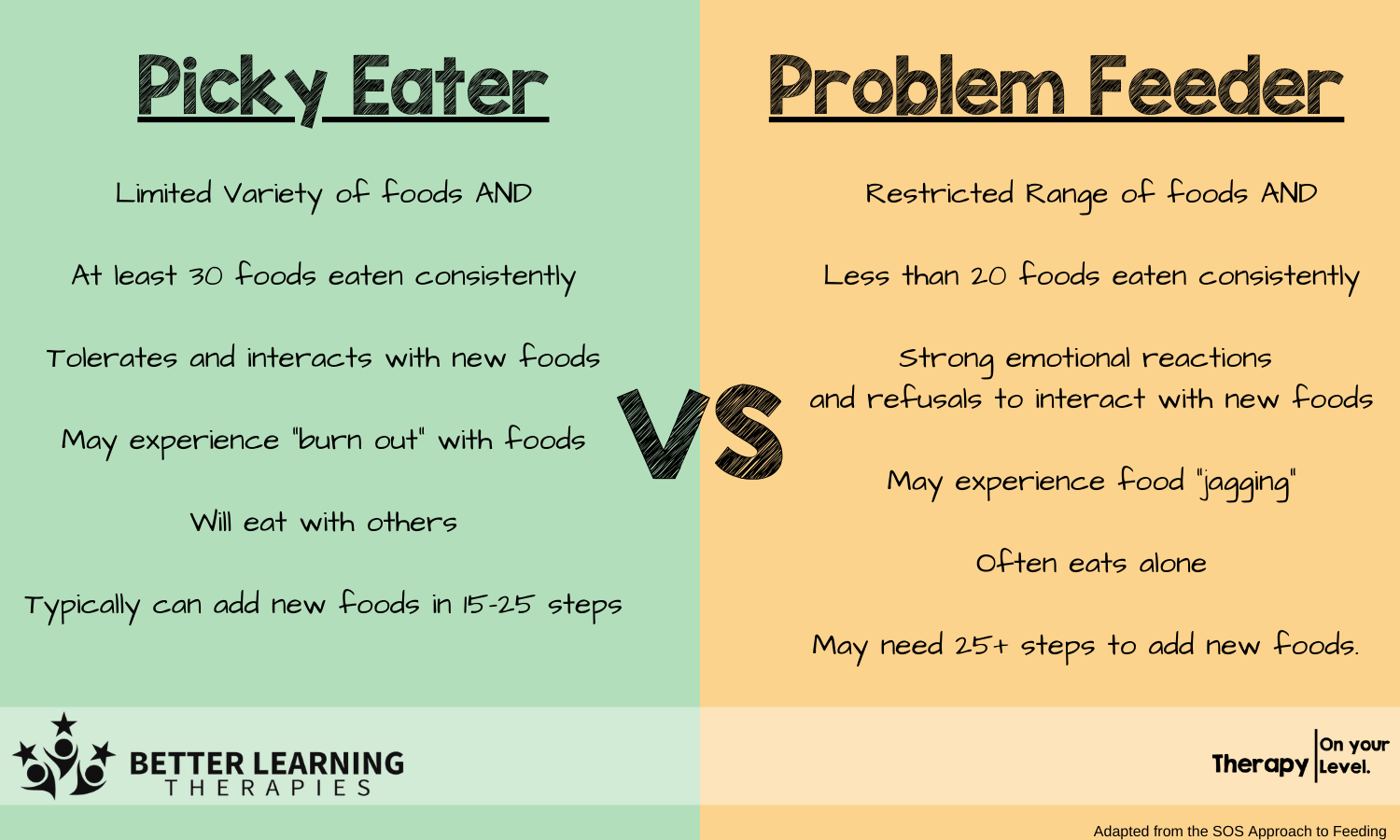Is My Child a Picky Eater or Problem Feeder?
A frequent question we are asked as feeding therapists is how we differentiate between a picky eater and a problem feeder. Read on to learn more.
Steps to Eating
A common myth associated with feeding is that eating is a two-step process; 1 = you sit down, 2 = you eat. In fact “there are actually about 25 steps for typically developing children and 32 steps or more for children with feeding problems, in the process of learning to eat.” (Top 10 Myths - SOS Approach to Feeding) The image below breaks down the steps involved with eating and feeding.
Picky Eaters
A child can be considered to be a picky eater if they have a limited variety of foods, but have at least 30 foods in their food repertoire that they will eat consistently. Occasionally, children will “burn out” from certain foods. A picky eater will typically regain that food after a two-week break. While there is avoidance when introduced to a new food, a child that demonstrates picky eating will be comfortable enough to tolerate the food on the plate and can interact with the novel food at various levels, including smell, touch, and even taste. Additionally, a child with picky eating behavior will eat at least one food from all nutrition groups or food textures (i.e. purees, meltable foods, vegetables, fruits, proteins, etc.).
With that in mind, picky eaters are able to add new foods to their repertoire in 15-25 steps.
Furthermore, the child with picky eating may eat different foods than their family, but will typically be involved during mealtimes and eat with the family. These children may sometimes be reported as “picky eaters” at wellness checkups.
Problem Feeder
A child with problem feeding behaviors has a restricted range of food, typically less than 20 foods they will eat consistently. When problem feeders “burn out” from foods in their repertoire, they are typically lost and not reacquired. This is called food jagging. A child experiencing meltdowns when they are introduced to novel foods is another sign of problem feeding. They refuse to interact with new foods presented and experience strong emotional reactions. Children with problem feeding will refuse entire categories of food textures or nutrition groups (i.e. will only eat carbohydrates). It also takes these children longer to add foods to their diet and with a greater number of steps (25 or more).
Much like picky eaters, problem feeders eat different foods than their family at mealtimes, but in contrast, these children are more likely to often eat alone. Children with problem feeding are persistently reported as “picky eaters” across multiple wellness checkups.
It is important to make this distinction in order to receive the necessary help and seek intervention options for problem feeding behaviors to prevent other issues down the road.
When to Seek Help
Know that there is hope and help for the Picky Eaters and Problem Feeders in your life. While picky eating is normal, there are some signs you shouldn’t ignore. Pay attention to your stress level and your child’s stress regarding meals. Parents don’t need to feel desperate or guilty and your child doesn’t need to feel distressed. Pay attention to changes in your child’s diet. While it’s normal for a child to go through phases it’s important to note dramatic or permanent changes.
Are you still wondering about your child? Check out this Picky Eaters vs Problem Feeders Questionnaire from the SOS Approach to Feeding website. There are also lots of resources there for parents and families.
Sometimes children need additional support from a feeding therapy program. You don’t have to wait for your child to just outgrow it. While some kids do outgrow feeding issues, some won’t without extra help.
At Better Learning Therapies, our Feeding Therapists specialize in assessing and treating all of the reasons why infants and children won’t eat. Our focus is on supporting parents and children to eat a wide variety of nutritious foods in order to support their best growth. Our therapists typically use the SOS Approach to Feeding program, a nationally and internationally recognized approach for assessing and treating children with feeding difficulties, but we have additional skills and training and will work with you, your family and our colleagues to find the best possible treatment plan for you all.
Call or book an appointment online to talk to one of our staff members about the best options for your child.







